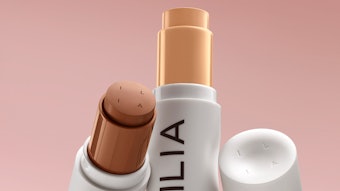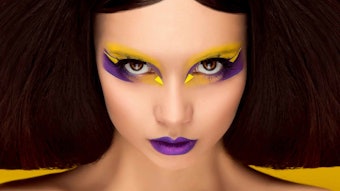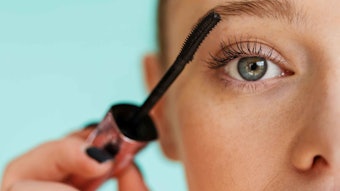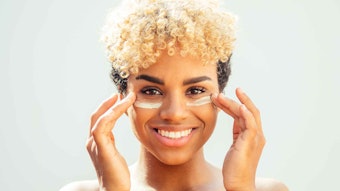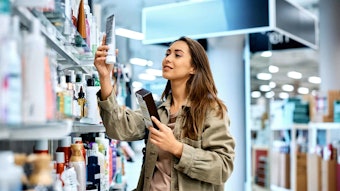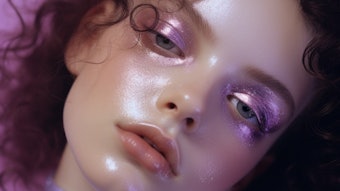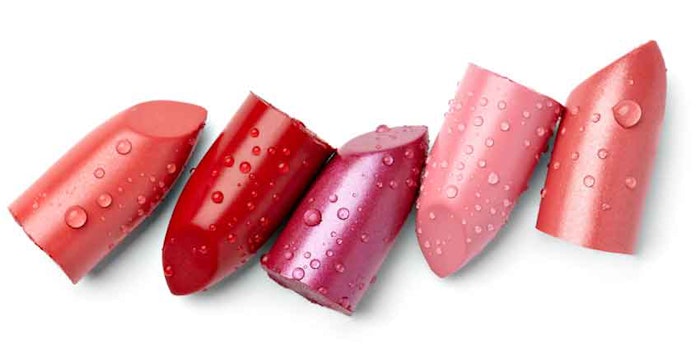
Lips are perhaps the most sensual part of the face and play a major role in perceived beauty.1, 2 They are also in constant motion and exposed to physical and chemical changes that alter and impact their normal form, as evidenced by wrinkles and dryness. The histology of the lips is well-described, and the vermilion area where the lips end and facial skin begins is covered by a thin stratum corneum made up of orthokeratotic cells that have a shorter turnover rate than the normal stratum corneum.3
Unlike other skin, the lips lack epidermis, and with a thickness of just three to five cellular layers, they are very thin compared with typical facial skin, which has up to 16 layers.4 Lighter colored lip skin also contains fewer melanocytes, which protect lips and impart color—as do blood vessels, as they appear through the thin lip skin. Further, the lip skin is not hairy and does not have sweat glands, therefore it does not have the usual protective layer of sweat or body oil to keep the skin smooth, inhibit pathogens or regulate warmth. For these reasons, the lips dry out faster than other skin and become chapped more easily.5 Preliminary studies have shown that lips lose five times more water than body skin.
To improve the appearance of dry and wrinkled lips, it is therefore necessary to hydrate them with emollients and moisturizers—and a lipstick designed to highlight the beauty and color of lips as well as moisturize them meets both fashion and function needs.6 To this end, several ideas were considered before the author began work on a final product concept; this process is described here. The resulting lipstick was then tested for immediate and long-lasting moisturization using a corneometera, and a quantitative study was conducted with female users to rate the usability of the lipstick.
Formulation Concept
As noted, a lipstick concept was envisaged to provide high levels of hydration to the lips. Moisturization can be accomplished by occlusion, i.e., preventing water loss by coating the skin to trap moisture in—essentially, replicating what a healthy sebum balance already does. This approach is common among many brands, and staple ingredients include petroleum, mineral oil and lanolin.
Thus, previous attempts were made by the author to improve the moisture efficacy of traditional lipsticks (data not shown) by incorporating ceramides; oil components; products with beeswax, shea butter and vitamin E; or oils such as jojoba, olive and coconut. These provided lips with adequate moisture via occlusion. While these are somewhat effective, such products can also clog pores and cause contact irritation due to their oil content.
Other products attract moisture to the skin using hydrophilic substances like water, glycerin, lactic acid and some vitamins. Therefore, this approach to impart high hydration was preferred. However, traditional lipstick formulas include high levels of oils and waxes to create their stick form. This posed a formulating challenge since water and other hydrophilic materials alter the polarity of the formula and are incompatible with the many anhydrous waxes and oils used, causing instabilities. For example, water changes the appearance and blooming of waxes and oils. Also, due to its volatile nature, water evaporates, reducing the size of the stick unless it is protected by airtight packaging.
Further, the addition of mineral salts to the lipstick formula was desired for this concept. In lipstick formulas, innovations generally are limited to texture, application form, packaging and color, so a new claim was desired. Considering recent claims for cosmetics relating beyond color and beauty to care and health, the idea was to use mineral salts to give the same impression that sports beverages do: that the lips needs these components to rehydrate.
Considering the stability challenges of incorporating water and mineral salts in lipstick, the author determined that encapsulation may be the best approach. A delivery system based on solid hydrophobic nanospheres encapsulated in water- or pH-sensitive microspheresb was therefore employed. This system can be adjusted to release ingredients in a given manner, making it possible to retain high levels of volatile ingredients such as water and improve ingredient stability, especially upon exposure to heat—since lipstick often is heated to 100°C during processing. Leveraging this multi-tasking delivery capability, a complex of vitamins and mineral salts also was included with the encapsulated water with the goal to rehydrate and refresh the lips.
After much trial and error, the encapsulated materials were successfully added to the formulation using emulsifiers. The preloaded encapsulated nanospheres were combined in the water phase and manually homogenized. The water phase was then added to the oil phase and stirred using a homogenizer. In some cases, bubbles formed in the batch during mixing, in which case vacuum equipment was employed. The final compositions included: waxes, polyethylene, carnauba wax, emulsifier, water, glycerin, encapsulated mineral salt, pigments, diisopropyl dimer dilinoleate, antioxidants and fillers. The delivery system aided in product stability, as clear by both the absence of any impact on bloom and absence wax or fat exuding from the lipstick. The final formulation was then compared with other commercial products making “moisturization” claims.
Materials and Methods
Several tests were performed comparing the lipstick with the nanospheres to a competitor’s “moisturizing” lipstick (i.e., without nanospheres) and lips without lipstick as the basal control. First, changes in moisturization levels were measured in a panel of 31 women, ages 25-45 years, using a corneometera. A technician applied the test lipstick with nanospheres once to each of the women. Readings were taken 5 min after application, 5 hr after application and 24 hr after application (the women left the product on their lips overnight to achieve the 24-hr measurement). The same test was carried out in an additional panel of 31 women having the same characteristics to assess the basal control and the competitor’s moisturizing lipstick.
In a separate blind study, 101 healthy women, ages 25 to 45 years of both a low and medium-low socioeconomic status, were surveyed at home to gather their responses to using the test product after one week. The women compared two products: the lipstick with and without nanospheres and a benchmark competitor brand. Women working in the cosmetics or related industries were excluded from the study. The women were instructed to use the lipsticks at least two or three times daily, applying the amount they normally would. At the end of the test, the women filled out questionnaires.
Results and Discussion
The corneometer results shown in Figure 1 indicate the test lipstick significantly increased the moisture level of the semimucous lip area: immediately, where it showed up to 57.89% moisture improvement; at 5 hr, a 94.74% improvement; and at 24 hr, up to 150% improvement, over the control, i.e., lips without lipstick. In comparison, the benchmark competitor’s lipstick with a moisturizing claim provided an immediate moisture improvement of up to 66.0%; up to 28.57% improvement at 5 hr; and at 24 hr, up to 42.86% improvement over the control. These differences were statistically significant and attributable to the encapsulation technology.
By homogenously distributing its nanosphere payload, the delivery system kept the active moisturizing ingredients bioavailable—and this cycle began again with each application to the lips. Since the delivery system prolongs the effective concentration of actives, they are also better utilized, which reduces the number of applications necessary for longer-lasting results, and reduces any toxicity risk.
For the survey, several questions were posed, but only those related to moisturization are included here; survey results are shown in Figures 2, 3, 4, 5, 6 and 7. How do you rate the quality of lipstick Y?: 85% responded very good and excellent. How moisturized do your lips feel with lipstick Y?: 75% of respondents answered highly moisturized and moisturized. Did lipstick Y reduce the appearance of wrinkles in your lips?: 71% said that lipstick reduced the appearance of wrinkles and small lines in the lips. Do you feel that lipstick Y provides long-lasting moisture?: 72% responded yes. : 83% said yes. If you replied yes to the cDid you feel a cooling (refreshing) effect when using lipstick Y?ooling effect, do you feel this related to a moisturizing effect?: 74% responded they agree or completely agree.
Conclusions
The use of encapsulated actives in the described anhydrous lipstick formulation increased levels of moisturization up to 150% after 24 hr. Further, as the survey showed, relating this improved efficacy with sensory benefits such as improved feel and texture reinforced its use and appeal by consumers. In this case, the inclusion of water and mineral salts provided a refreshing sensation on the lips, making the product attractive to consumers.
References
1. BBC News, Lip size key to sexual attraction, available at http://news.bbc.co.uk/2/hi/health/2817795.stm (Accessed Jul 29, 2013)
2. JL Lévêque and E Goubanova, Influence of age on the lips and perioral skin, Dermatology 208 30713 (2004)
3. C Edwards, R Heggie and R Marks, A study of differences in surface roughness between sun-exposed and unexposed skin with age, Photodermatol Photoimmunol Photomed 19 169-74 (2003)
4. AW Barrett, M Morgan, G Nwaeze, G Kramer and BK Berkovitz, The differentiation profile of the epithelium of the human lip, Arch Oral Biol 50 431-8 (2005)
5. H Kobayashi and H Tagami, Functional properties of the surface of the vermilion border of the lips are distinct from those of the facial skin, Br J Dermatol 150 563-7 (2004)
6. P López-Jornet, F Camacho-Alonso and A Rodríguez-Espin, Study of lip hydration with application of photoprotective lipstick: Influence of skin phototype, size of lips, age, sex and smoking habits, Med Oral Patol Oral Cir Bucal 15(3) e445-50 (May 2010)

